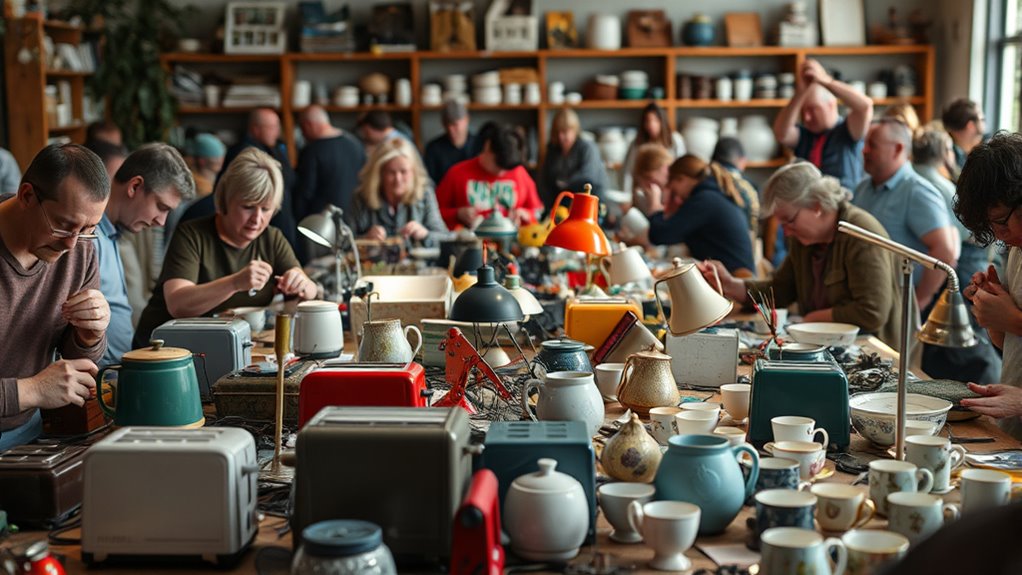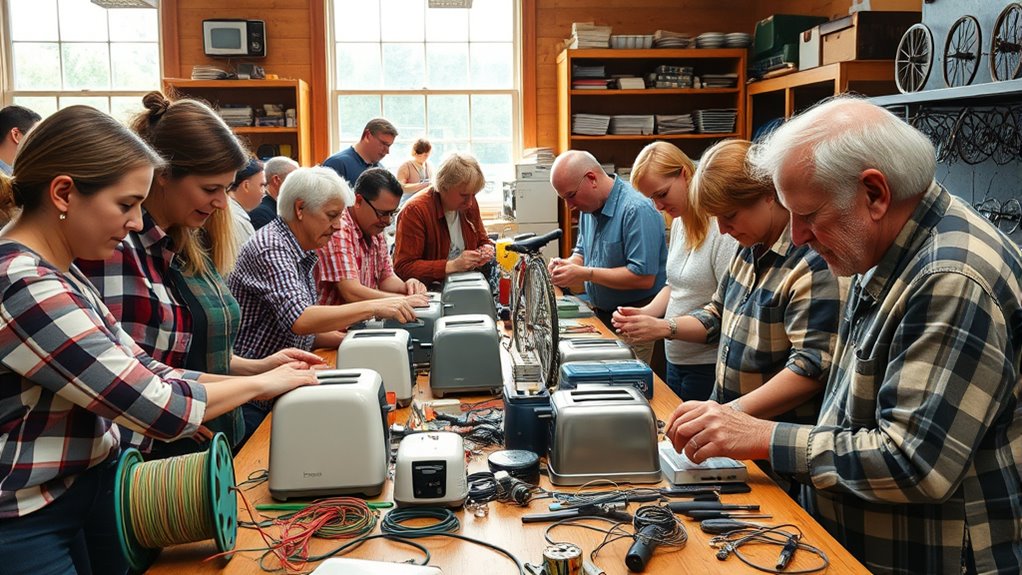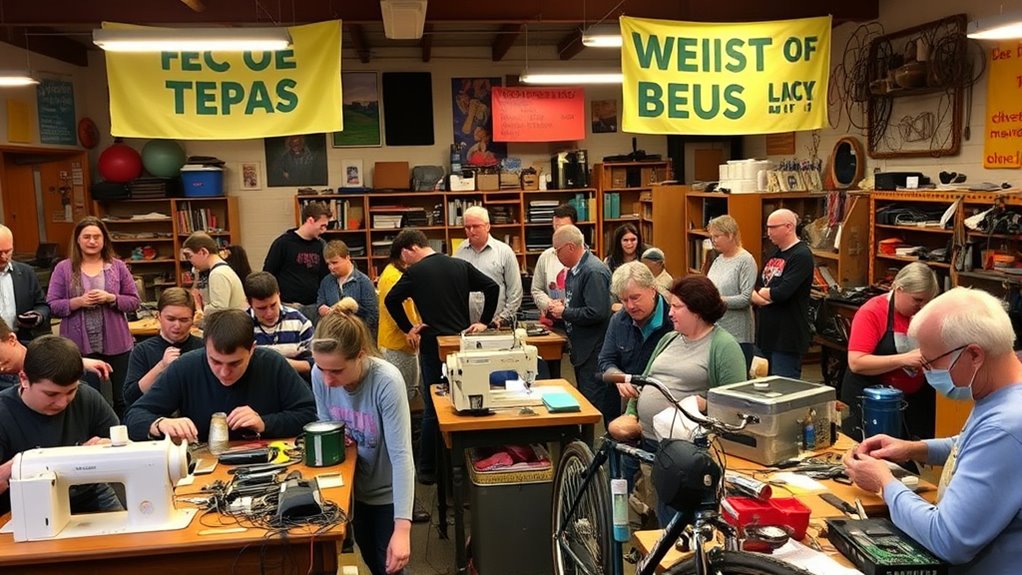Repair Cafés started in the Netherlands in 2009 to help people fix items instead of replacing them, reducing waste and promoting sustainability. Volunteers and experts share skills to repair electronics, clothing, and furniture, helping the environment and building community spirit. By fixing items, you can lower your carbon footprint while strengthening local connections. If you’re interested in learning how Repair Cafés grow and how you can participate, keep exploring this eco-friendly movement.
Key Takeaways
- Repair Cafés promote fixing items locally, reducing the need for replacement and minimizing environmental impact.
- They encourage community skill sharing, empowering residents to repair appliances, electronics, and clothing instead of discarding them.
- These initiatives extend product lifespans, decrease waste, and support sustainability through reuse and recycling practices.
- Repair Cafés foster eco-conscious habits by raising awareness about resource conservation and circular economy principles.
- They provide accessible spaces where volunteers and experts collaborate to repair items, turning waste into valuable resources.
The Origin and Evolution of Repair Cafés

Repair Cafés began as a grassroots movement aimed at reducing waste and promoting sustainability. It started in the Netherlands in 2009, when a group of volunteers organized events where people could bring broken household items to fix together. The idea was simple: prevent useful things from ending up in the trash by offering free repair services. As word spread, more communities adopted the concept, tailoring it to local needs. Over time, Repair Cafés evolved beyond just fixing appliances, expanding to include electronics, clothing, and furniture. The movement gained momentum worldwide, inspiring countless volunteers and organizations. Today, Repair Cafés serve as hubs for community engagement, skill sharing, and environmental consciousness, all rooted in the original goal of encouraging people to repair instead of replace. Digital tools like online scheduling platforms and social media also play a role in supporting these community initiatives, helping organizers coordinate events and share knowledge more effectively. Additionally, the emphasis on community engagement helps foster a sense of shared responsibility for environmental impact. Incorporating repair techniques into the movement has further empowered individuals to maintain their belongings longer and reduce waste, especially as AI security solutions could someday assist in providing remote repair guidance and safety protocols.
How Repair Cafés Promote Sustainability and Reduce Waste

Because they encourage you to fix items instead of discarding them, Repair Cafés play a pivotal role in promoting sustainability and reducing waste. By extending the lifespan of possessions, they help decrease the demand for new products, which in turn lowers resource extraction and energy consumption. Here are four ways they achieve this:
Repair Cafés extend item lifespans, reduce waste, and promote sustainable living through mindful fixing and community awareness.
- Reducing landfill contributions – repaired items stay out of waste bins longer.
- Conserving raw materials – fewer new goods mean fewer natural resource extractions.
- Lowering carbon footprints – less manufacturing results in reduced greenhouse gas emissions.
- Raising awareness – communities become more conscious of sustainable practices, including resource conservation. Promoting circular economy principles, these initiatives help embed sustainable habits into daily life. Additionally, fostering a repair culture encourages ongoing community engagement with sustainable practices and responsible consumption. Recognizing the importance of waste reduction strategies, Repair Cafés also serve as educational platforms for sustainable living.
Additionally, encouraging repair practices aligns with ongoing efforts in international finance to promote sustainable development and responsible consumption.
Together, these actions foster a culture of mindful consumption and waste reduction, making Repair Cafés essential for a sustainable future.
The Role of Volunteers and Experts in Repair Cafés

Volunteers and experts form the backbone of Repair Cafés, bringing a diverse range of skills and knowledge to each session. As a volunteer, you might help diagnose problems, handle tools, or offer guidance on repairs. Experts, on the other hand, often possess specialized skills—such as electronics, sewing, or appliance repair—that guarantee complex issues are addressed efficiently. Your collaborative effort creates a welcoming environment where people feel comfortable learning and sharing knowledge. Volunteers’ enthusiasm and expertise empower community members to extend the life of their belongings. This teamwork fosters a sense of community and encourages a culture of sustainability. Whether you’re fixing a bicycle or mending a lamp, your contribution helps reduce waste and promotes a hands-on approach to problem-solving. Additionally, having a good understanding of dog names can sometimes make interactions more personable and fun for volunteers working with pet-related repairs or donations. Recognizing the importance of community engagement can help motivate more people to participate and support these initiatives. Incorporating skilled repair techniques can also enhance the effectiveness of the repair sessions and inspire confidence among participants. Developing a mindful approach can further improve the patience and focus needed during repairs, creating a more positive experience for everyone involved. Building awareness of sustainable practices within the community can lead to more environmentally conscious repair efforts and long-term benefits.
The Economic and Environmental Benefits of Fixing Items

Engaging in repair activities at Repair Cafés not only fosters community skills but also delivers significant economic and environmental advantages. When you choose to fix rather than replace, you save money and reduce waste. Here are some key benefits:
- Cost savings by extending the lifespan of your belongings.
- Reduced demand for new products, lessening resource extraction and manufacturing energy.
- Decreased landfill waste, lowering environmental pollution.
- Lower carbon footprint associated with manufacturing, transportation, and disposal.
- Incorporating automation in repair processes can further enhance efficiency and accessibility.
- Properly diagnosing issues, such as headphone connection problems or driver failures, can prevent unnecessary replacements and promote sustainable practices. Utilizing repair techniques that are supported by proper diagnostic tools can streamline the process and ensure long-term functionality. Additionally, understanding the principles of air filtration technology can help optimize the repair and maintenance of air purifiers for continued health benefits, drawing inspiration from dog breeds known for their health resilience and adaptability.
Community Building Through Repair Initiatives

When you participate in repair initiatives, you help strengthen local connections and build trust within your community. Sharing skills with neighbors not only solves problems but also creates a sense of collective pride. These efforts turn simple repairs into opportunities to foster lasting relationships and community spirit. Engaging in these activities can also promote recycling and sustainability, reinforcing environmentally conscious habits among residents. Additionally, organizing and participating in repair events can raise awareness about community engagement and shared responsibility.
Strengthening Local Connections
Repair Cafés serve as vibrant hubs where community members come together to fix items and share skills, fostering a sense of connection and mutual support. By participating, you strengthen local bonds and create a shared sense of purpose. These gatherings encourage interaction beyond just repairs, building trust and camaraderie. To deepen these connections, consider:
- Hosting themed repair days for specific items or skills.
- Creating local networks to exchange tools and resources.
- Organizing community events that celebrate successful repairs.
- Promoting storytelling around repair successes to inspire others.
Through these actions, you can transform Repair Cafés into essential community centers promoting social cohesion, resilience, and a collective commitment to sustainability. The more you engage, the stronger your neighborhood’s fabric becomes.
Promoting Shared Skills
Promoting shared skills at Repair Cafés encourages community members to learn from one another and build collective expertise. When you participate, you not only fix items but also pass on valuable knowledge, empowering everyone involved. This exchange fosters trust and cooperation, strengthening community bonds. By sharing skills, you help create a culture of sustainability and self-reliance. To visualize this, consider the following:
| Skill Level | Example Activity |
|---|---|
| Beginner | Learning basic sewing |
| Intermediate | Repairing small appliances |
| Expert | Restoring vintage electronics |
| Mentor | Teaching others in the group |
This collaborative environment makes repair accessible and encourages ongoing learning, ultimately transforming neighbors into skill-sharing allies.
Fostering Community Pride
Community pride blossoms when residents come together through repair initiatives, turning individual efforts into a shared celebration of sustainability and ingenuity. When you participate in a Repair Café, you build connections with neighbors, fostering a sense of belonging and collective accomplishment. This involvement demonstrates that caring for your community’s environment is a shared responsibility. To enhance this pride, consider these key aspects:
- Celebrating local skills and talents through collaborative projects
- Creating a visible impact by restoring damaged items and beautifying shared spaces
- Sharing stories of successful repairs to inspire others
- Promoting a culture of sustainability that residents can rally around
Through these actions, repair initiatives become more than fixing; they transform into empowering expressions of community identity.
Getting Involved: How to Find or Start a Repair Café

To get involved, start by finding nearby Repair Cafés through online directories or community boards. If none exist in your area, consider launching your own by gathering a team and spreading the word. Taking these steps helps you join or create a space where people can repair and reuse items together.
Locate Nearby Centers
Finding a nearby Repair Café is easier than you might think, thanks to various online resources and networks. You can start by visiting dedicated websites that list local centers, often searchable by zip code or city. Social media groups and community bulletin boards also provide updates on nearby repair events. Additionally, many cities host directories or apps that connect you to the closest Repair Café. To help you get started, consider these options:
- Use online directories like Repair Café International Foundation’s website
- Search local community Facebook groups or forums
- Check with your city’s community centers or libraries
- Look for regional or city-specific repair networks and calendars
These tools make it simple to find a Repair Café near you and join the movement to fix instead of replace.
Launch a New Initiative
Starting a Repair Café can be a rewarding way to promote sustainability and build connections in your community. To launch one, start by gathering a team of passionate volunteers who share your vision. Identify a suitable location, like a community center or library, and secure necessary permissions. Spread the word through social media, flyers, and local groups to attract participants and donors. Develop a plan for workshops, tools, and materials needed to facilitate repairs. Register your initiative with existing networks or organizations to gain support and credibility. Host an opening event to generate interest and showcase your goals. Keep communication open and gather feedback to improve your sessions. With dedication, you can create a thriving space that encourages repair, reuse, and community bonding.
Frequently Asked Questions
What Types of Items Can Be Repaired at a Repair Café?
When you visit a repair café, you can bring a variety of items for fixing. Commonly, you’ll find repairers working on electronics, small appliances, furniture, clothing, bikes, and even toys. These spaces aim to help you prolong the life of your belongings, so don’t hesitate to bring items that need minor repairs or maintenance. It’s a great way to save money and reduce waste while learning new skills.
Are Repair Cafés Free or Do They Charge for Services?
You might wonder if repair cafés charge for their services. Usually, they operate on a donation basis or are entirely free, aiming to make repairs accessible without added costs. Volunteers help you fix items like electronics, clothing, or small appliances, so you don’t have to pay for professional repairs. Keep in mind, some cafés might ask for a small donation to cover materials or refreshments, but overall, the service is budget-friendly.
How Do Repair Cafés Ensure Safety During Repairs?
Think of repair cafés as safety nets woven with care. You’re guided by skilled volunteers who follow strict safety protocols, like wearing gloves and goggles, to keep everyone protected. They use proper tools, clear instructions, and guarantee your item is safe to fix. These measures act like a shield, making sure you can mend your belongings confidently, knowing that safety is their top priority during every repair.
Can Businesses or Schools Partner With Repair Cafés?
You can definitely partner with repair cafés to benefit your business or school. By collaborating, you provide a space for skill-sharing and sustainability education, engaging your community. You might host repair workshops or donate items for fixing. These partnerships promote environmental responsibility and foster teamwork. Reach out to local repair cafés to explore ways you can work together, making a positive impact while encouraging repair and reuse practices.
What Are Common Challenges Faced by Repair Cafés?
Like Icarus soaring too close to the sun, repair cafés face challenges that threaten their flight. You might encounter limited resources, volunteer burnout, or insufficient public awareness, making it tough to sustain momentum. These hurdles can feel overwhelming, but with community support, clear communication, and strategic planning, you can overcome them. Remember, even Daedalus’s wings needed careful crafting—so too, your repair café needs resilience and dedication to thrive.
Conclusion
Repair cafés are transforming how you see fixing things—saving money, reducing waste, and building community along the way. But their true power might surprise you, waiting just around the corner. Will you step up, get involved, and discover the impact you can make? The next repair could be your chance to change more than just an item—it could change how you connect with your world. Are you ready to find out what’s possible?









